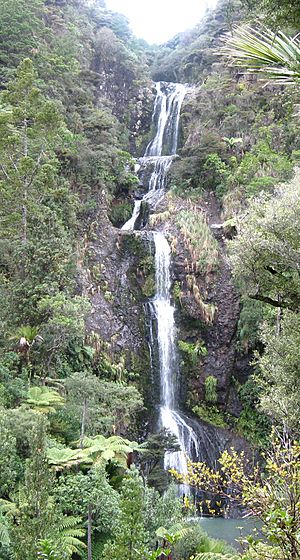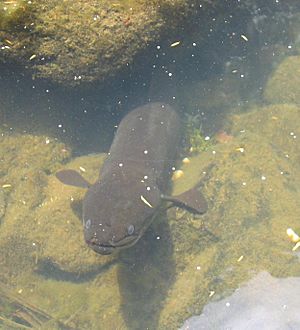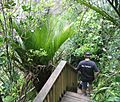Kitekite Falls facts for kids
Kitekite Falls (sometimes called Kitakita Falls) is a beautiful three-tiered waterfall near Auckland, New Zealand. The water drops a total of 40 metres (130 feet). If you look from the Kitekite track lookout, the falls seem even taller. This is because white water flows over rocks from an upper swimming hole into a small pool, then into a large pool, and finally to another small pool before the main 40-metre drop. This makes the total height closer to 80 metres (260 feet)! These amazing falls are found on the Glen Esk stream, close to Piha Beach.
Contents
Exploring Kitekite Falls: The Walk
The walking track to Kitekite Falls reopened on Boxing Day in 2018. More covered walkways were added to help protect the native kauri trees. The track had been closed because of a tree disease called kauri dieback. It was also closed under a special Māori restriction called a rāhui. This was put in place by Te Kawerau ā Maki, a local Māori tribe, along with the Waitākere Ranges Local Board and Auckland Council. The rāhui means that all forest tracks are closed to protect the trees.
To start your adventure, you can find clear signs from the carpark at the end of Glenesk Road.
The Kitekite loop track is very popular, with about 30,000 visitors each year (as of 2005). It follows the Glen Esk Stream with gentle ups and downs. On the south side, the track leads to a lookout point with a large wooden bench. From here, the track goes down wooden steps to the bottom of the falls. This part of the walk takes about 40 minutes from the carpark.
After reaching the base of the falls, the track crosses the stream next to a lower swimming hole. It then returns down the north side. If you're feeling energetic, you can also climb a fairly steep path called the Connect Track. This track starts about 100 metres from the base of the falls on the northern side of the stream. It takes about 15 minutes to reach the top of the falls, where you'll find another swimming hole!
A Look Back: History of the Falls
The area around Kitekite Falls was once a busy place for logging. Kauri trees were cut down and processed from 1910 to 1921. All the large, old trees in the area were removed during this time.
If you look closely at the top of the falls, you can still see notches cut into the rocks. These were rectangular cutouts where large wooden beams rested. This was the exact spot of the Glen Esk dam. The first time logs were tried to be sent down the falls, they broke apart on the rocks below. After that, the dam was only used to create a rush of water to help flush logs waiting in the stream further down to the mill.
You can still find pieces of the heavy wooden beams from the dam in the stream today. They sometimes move around with the water. In 2007, one of these beams fell, broke, and half of it got stuck in the rocks at the base of the three-tiered falls.
Amazing Plants and Animals: Local Flora and Fauna
It has taken many decades for the young kauri trees (Agathis australis), also known as 'rickers', to grow back. They are finally starting to poke through the forest canopy again. You can see many sharp, cone-shaped rickers from the Kitekite loop track near the falls. When kauri trees are about 100 years old, their tops start to spread out. It's now almost 100 years since the logging stopped, so many trees are reaching this stage. Their crowns usually keep growing wider for another 500 years!
As you walk to the falls, you'll pass through a patch of nikau palms. Here, you'll often hear the unique call of the Tui (bird) from above. Other native plants you might spot include silver tree ferns, puriri trees (whose red berries attract kereru, the native pigeon), and the rangioroa plant. The rangioroa is sometimes called 'bushman's friend' because the underside of its broad leaves is very soft. A rare type of moss, Fissidens rigidulus var. pseudostrictus, has also been found growing in the wet areas of the falls.
If you're lucky, you might even spot New Zealand longfin eels (Anguilla dieffenbachii) hiding among the rocks around the base of the falls.
Understanding Place Names
The name 'Kitekite' is actually a mistake! The original name was Kitakita. In a Māori/English dictionary, the word 'Kitakita' means 'to be bright' (for colours), 'tightly', 'fast', or 'intensely'. The 'i' in Māori is pronounced like the 'ee' in the English word 'sleep'.
The 'Glen Esk' stream was named by Dr William Stockwell. He moved to New Zealand in 1876 and bought land above Kitekite Falls soon after arriving. He named the area 'Glen Esk' because it reminded him of his home in Scotland. 'Glen' comes from Gaelic, a language spoken in Scotland and Ireland, and means 'valley'. 'Esk' is from a Celtic language and means 'water'. So, Glen Esk means 'water valley'.
Adventure Activity: Canyoning
Kitekite Falls is also used for an adventure sport called canyoning. This involves traveling down canyons using various techniques like walking, climbing, jumping, abseiling (rappelling), and swimming. Only licensed operators are allowed to offer canyoning tours here.
When the licence for canyoning was first given in 2002, some local residents were worried about how it might affect the environment at Kitekite Falls. However, the Auckland Regional Parks recreation coordinator at the time said there were no concerns. This fun activity continues today and is closely watched by the council to make sure it's done safely and responsibly. Climbing on the falls (going off the marked track) is strictly not allowed. You can only do this with a special permit or a licensed guide. These rules are in place to protect the rare moss that grows in the wet parts of the waterfall.
Images for kids









